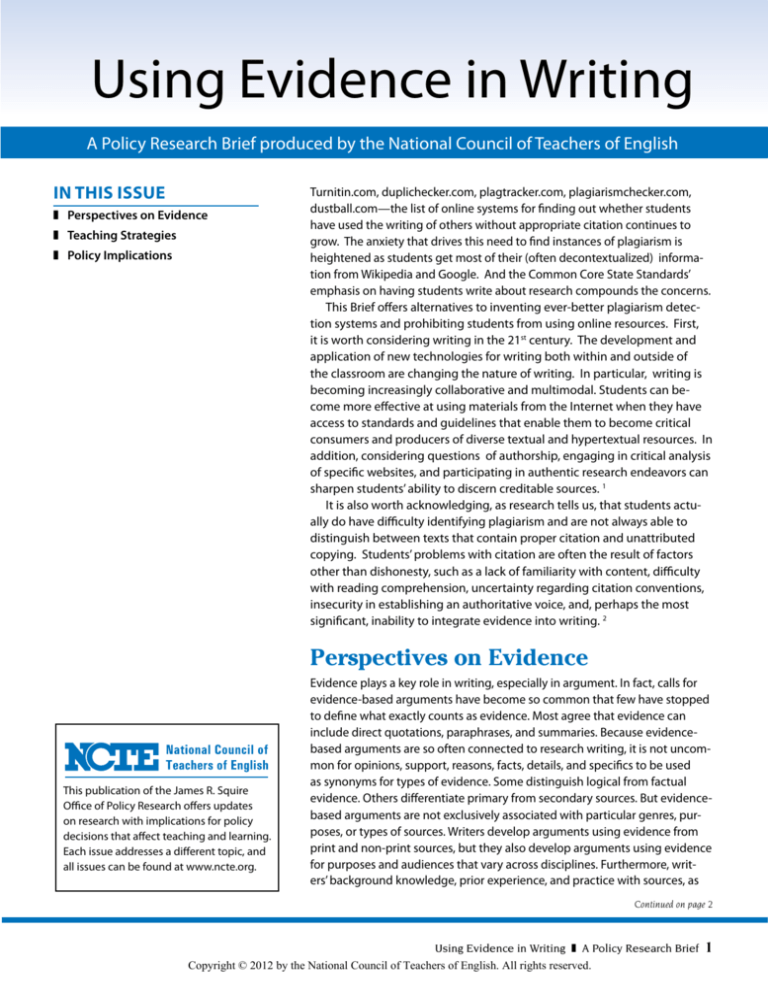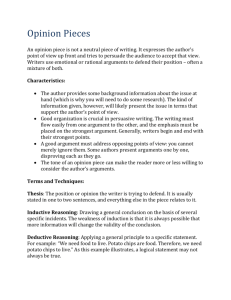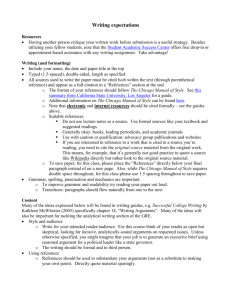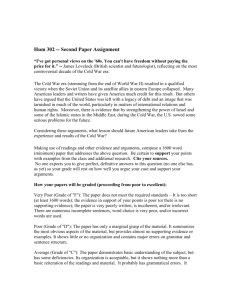
Using Evidence in Writing
A Policy Research Brief produced by the National Council of Teachers of English
In This Issue
Perspectives on Evidence
Teaching Strategies
Policy Implications
Turnitin.com, duplichecker.com, plagtracker.com, plagiarismchecker.com,
dustball.com—the list of online systems for finding out whether students
have used the writing of others without appropriate citation continues to
grow. The anxiety that drives this need to find instances of plagiarism is
heightened as students get most of their (often decontextualized) information from Wikipedia and Google. And the Common Core State Standards’
emphasis on having students write about research compounds the concerns.
This Brief offers alternatives to inventing ever-better plagiarism detection systems and prohibiting students from using online resources. First,
it is worth considering writing in the 21st century. The development and
application of new technologies for writing both within and outside of
the classroom are changing the nature of writing. In particular, writing is
becoming increasingly collaborative and multimodal. Students can become more effective at using materials from the Internet when they have
access to standards and guidelines that enable them to become critical
consumers and producers of diverse textual and hypertextual resources. In
addition, considering questions of authorship, engaging in critical analysis
of specific websites, and participating in authentic research endeavors can
sharpen students’ ability to discern creditable sources. 1
It is also worth acknowledging, as research tells us, that students actually do have difficulty identifying plagiarism and are not always able to
distinguish between texts that contain proper citation and unattributed
copying. Students’ problems with citation are often the result of factors
other than dishonesty, such as a lack of familiarity with content, difficulty
with reading comprehension, uncertainty regarding citation conventions,
insecurity in establishing an authoritative voice, and, perhaps the most
significant, inability to integrate evidence into writing. 2
Perspectives on Evidence
This publication of the James R. Squire
Office of Policy Research offers updates
on research with implications for policy
decisions that affect teaching and learning.
Each issue addresses a different topic, and
all issues can be found at www.ncte.org.
Evidence plays a key role in writing, especially in argument. In fact, calls for
evidence-based arguments have become so common that few have stopped
to define what exactly counts as evidence. Most agree that evidence can
include direct quotations, paraphrases, and summaries. Because evidencebased arguments are so often connected to research writing, it is not uncommon for opinions, support, reasons, facts, details, and specifics to be used
as synonyms for types of evidence. Some distinguish logical from factual
evidence. Others differentiate primary from secondary sources. But evidencebased arguments are not exclusively associated with particular genres, purposes, or types of sources. Writers develop arguments using evidence from
print and non-print sources, but they also develop arguments using evidence
for purposes and audiences that vary across disciplines. Furthermore, writers’ background knowledge, prior experience, and practice with sources, as
Continued on page 2
Using Evidence in Writing A Policy Research Brief
Copyright © 2012 by the National Council of Teachers of English. All rights reserved.
1
well as motivation for the task, also influence their ability to
choose and justify evidence; this background or contextual
knowledge may include familiarity with discourse and disciplinary ways of constructing arguments and contributing
new knowledge to ongoing discussions within a particular
field.3
Research tells us that the assessment of whether
evidence “counts” also depends upon how a writer uses
evidence to support an argument. Writers carefully select
evidence based on their chosen stance, purpose, and audience. Then writers use their chosen evidence to warrant,
or justify, their stance. In literary analysis, for example,
evidence from a literary text counts when citations include
specific details that support a particular argument about
the literature and when the writer sufficiently connects the
textual evidence with his or her stance. In historical writing,
too, determining the quality of evidence is equally about
how well the writer analyzes and interprets its significance.
A series of checks that both writers and audiences use to
weigh the quality of evidence and how well writers use
that evidence in support of an argument can facilitate this
process. These checks may include determining:
Relevancy—Assessing whether the evidence is appropriately topical and timely
Sufficiency—Accounting for all evidence, including
counterarguments, alternative perspectives, and/or
conflicting reports
Sourcing—Noting the author (including his or her
intentions) and context of the evidence
Credibility—Considering whether the source of the
evidence offers expertise on the subject
Accuracy & Verifiability—Judging whether the evidence is valid and trustworthy4
Another challenge student writers face in integrating
evidence into their writing is learning to respond to disciplinary patterns. In particular, they are often unfamiliar
with how evidence is valued, used, and analyzed differently in various disciplines, such as in science or in history.
Different disciplines have different “ways of knowing” and
“ways of thinking” that subject-area teachers need to make
explicit for students. Research has consistently found that
students invariably develop stronger and better-supported
arguments when the teacher has a deep knowledge of the
written argumentation model within their discipline and
provides scaffolding for students in the individual steps of
finding evidence and developing their arguments Some
steps in the process of incorporating evidence include:
Finding and interpreting sources
Evaluating the quality of the sources and data
2
Using Evidence in Writing A Policy Research Brief
Analyzing the data
Making connections between the source and the
argument
Incorporating a wide range of evidence into the
argument
Structuring the argument
Distinguishing strong arguments from weak arguments
When teachers scaffold discrete strategies, students—
especially lower-performing students—tend to develop
stronger academic literacies, produce stronger arguments,
engage in more critical thinking, and show deeper understanding of the content material.5
Teaching Strategies
Research offers a number of effective approaches teachers
can use to help students do a good job of incorporating evidence into their writing. Explicit teacher modeling of complex thinking processes has gained attention in the research
on reading strategy instruction. Recent research suggests that
modeling should be extended to writing tasks, as well. Explicitly modeling complex thinking tasks such as incorporating
evidence into a piece of writing enables students to both
view and internalize the process, as opposed to memorizing
abstract rules related to this process.6
Patchwriting is a term used to describe writing that is
not copied word for word but “restates a phrase or clause or
one or more sentences while staying close to the language
of the source.” It offers a teaching opportunity because
it demonstrates a misuse of evidence rather than actual
plagiarism. Too often misuse of evidence is framed entirely in terms of plagiarism or theft, but the more frequent
misuse of evidence results from carelessness, difficulty in
comprehending the source, or lack of knowledge about the
content. Teachers who deal with examples of patchwriting
can help students develop a more nuanced and thorough
understanding of what it means to misuse evidence. 7
Effective strategies for teaching students how to use
evidence in writing include:
Modeling the search for and appropriate use of
evidence from many types of sources (both printbased and Internet) and in different disciplines
Using patchwriting as a site for critical investigation of
questions surrounding the use of evidence
Replacing punishment-based reactions to naïve student
misuse of evidence with instruction-based ones
Attending to the needs of English language learners
who are dealing with the dual challenges of language
acquisition and incorporation of evidence
The James R. Squire Office of Policy Research
Involving students in authentic research endeavors
in an effort to facilitate discussions of the creation
of bodies of research and principles of academic
integrity
Policy Implications
From a policy perspective, students’ effectiveness in incorporating evidence into writing will be directly influenced
by the professional development opportunities afforded to
their teachers. Teachers who have access to the following
will be well prepared to teach students how to do an effective job of incorporating evidence into writing:
Provide training and/or workshops that give teachers
in all subject areas the opportunity to reflect on their
disciplinary practices and identify discrete writing
skills that students will need in order to develop wellsupported arguments.
Provide in-depth training in the writing process for
teachers, which will foster self-awareness of the ways
they write and how to meet their students’ needs
through scaffolding.
Make space in the curriculum for teachers to spend
more classroom time on explicit writing instruction
and guided writing practice.
Encourage all subject-area teachers to provide their
students with primary sources, whenever possible,
which has been shown to increase the amount of
evidence students use in their writing.
Endnotes
1 Jacobs, G. E. (2011). Chapter 6: Information gathering. Writing
instruction for generation 2.0. New York, NY: Rowman & Littlefield.
Kittle, P. and T. Hicks. (2009). Transforming the group paper with
collaborative online writing. Pedagogy: Critical Approaches to
Teaching Literature, Language, Composition, and Culture, 9(3), 525.
2 Deckert, G. D. (1993). Perspectives on plagiarism from ESL students in Hong Kong. Journal of Second Language Writing, 2(2),
131-48.
Roig, M. (1997). Can undergraduate students determine
whether text has been plagiarized? Psychological Record, 47(1),
113-23.
Shi, L. (2008). Textual appropriation and citing behaviors of
university undergraduates. Applied Linguistics, 31(1), 1-24.
3 Andrews, R., Torgerson, C., Low, G., & McGuinn, N. (2009). Teaching argument writing to 7‐ to 14‐year‐olds: An international review of the evidence of successful practice. Cambridge Journal
of Education, 39(3), 291-310.
Gleason, M. M. (1999). The role of evidence in argumentative
writing. Reading and Writing Quarterly, 15(1), 81-106.
Hyland, K. (1999). Academic attribution: Citation and the construction of disciplinary knowledge. Applied Linguistics, 20(3),
341-367.
Kiuhara, S. A., Graham, S., & Hawken, L. S. (2009). Teaching
writing to high school students: A national survey. Journal of
Educational Psychology, 101(1), 136-160.
Midgette, E., Haria, P., & MacArthur, C. (2008). The effects of
content and audience awareness goals for revision on the persuasive essays of fifth- and eighth-grade students. Reading and
Writing, 21(1/2), 131–151.
4 Belland, B. R., Glazewski, K. D., & Richardson, J. C. (2011).
Problem-based learning and argumentation: Testing a scaffolding framework to support middle school students’ creation of
evidence-based arguments. Instruction in Science 39, 667-94.
Lewis, W. E., & Ferretti, R. P. (2009). Defending interpretations
of literary texts: The effects of topoi instruction on the literary
arguments of high school students. Reading & Writing Quarterly,
25(4), 250–270.
Monte-Sano, C. (2011). Beyond reading comprehension and
summary: Learning to read and write in history by focusing on
evidence, perspective, and interpretation. Curriculum Inquiry,
41, 212–249.
5 Takao, A.Y., & Kelly, G,. J. (2003). Assessment of evidence in
university students’ scientific writing. Science and Education, 12,
341-363.
Zumbrunn, S., & Krause, K. (2012). Conversations with leaders:
Principles of effective writing instruction. The Reading Teacher,
(65)5: 346-353.
6 Andrews, R., Torgerson, C., Low, G., & McGuinn, N. (2009). Teaching argument writing to 7‐ to 14‐year‐olds: An international review of the evidence of successful practice. Cambridge Journal
of Education, 39(3), 291-310.
Berkeley, S., & Regan, R. (2011). Effective reading and writing
instruction: A focus on modeling. Intervention in School and
Clinic, 47(5), 276-282.
7 The citation project: preventing plagiarism, teaching writing.
Retrieved 9 September 2012 from: http://citationproject.net/
plagiarism-definition.html.
This policy brief was produced by NCTE’s James R. Squire Office of Policy Research, directed by Anne Ruggles Gere, with assistance from Elizabeth Homan,
Danielle Lillge, Justine Neiderhiser, Chris Parsons, Ruth Anna Spooner, Sarah Swafford, and Chinyere Uzogara.
For information on this publication, contact Danielle Griffin, NCTE Legislative Associate, at dgriffin@ncte.org (email) or 202-380-3132 (phone). ©2012
by the National Council of Teachers of English, 1111 W. Kenyon Road, Urbana, Illinois 61801-1096. All rights reserved. No part of this publication may be
reproduced or transmitted in any form or by any means, electronic or mechanical, including photocopy, or any information storage and retrieval system,
without permission from the copyright holder. Additional copies of this publication may be purchased from the National Council of Teachers of English
at 1-877-369-6283. A full-text PDF of this document may be downloaded free for personal, non-commercial use through the NCTE website:
http://www.ncte.org (requires Adobe Acrobat Reader).
Using Evidence in Writing A Policy Research Brief
3









